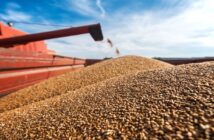With the weather finally warming up and fields starting to dry out, farmers may be beginning to be consider when to drill maize. Tim Richmond from LG Seeds says in recent years it has paid to hold back and wait until conditions are correct.
“Drilling time is a key decision when growing maize so it is vital to get it right,” Mr Richmond comments. “The advice is often to drill early to increase yields by giving a longer growing season. This has largely been overtaken by the development of early maturing varieties such as Prospect and Reason which yield well in a shorter season and will mature over 14 days earlier than the latest varieties”
He says drilling early can cause problems. If drilling early, the practice has usually been to sow at a higher seed rate to compensate for seed loss, but this just pushes up costs and is illogical. If you are going to lose seeds, he says you should not be sowing. If seed is drilled in cold soils, the rate of germination will be reduced. Early drilling is also seen as a way to ensure sufficient soil moisture, but this should not be a problem this season.
Mr Richmond says in recent years, farmers have been tempted to go early because there has been a spell of good weather in early April. However, Met Office data shows this has been a false dawn.
“In the last three years there has been an early peak in temperatures around 20-24th April in the high teens and early twenties, persuading farmers to push ahead. But data from our seven trial sites across the country show that this has been followed by a substantial temperature drop to below 8°C for 2-3 weeks. Temperatures did not consistently exceed 10°C until 4-13th May.”
He says seed drilled in early April in each of the last three years would have struggled to get away. It would either be chilled in dry soils or would rot in wet ground. Later drilled seed would have germinated much quicker and resulted in a stronger early crop.
“Based on this temperature data, in each of the last three years sowing should not have started before the end of April. Seed would have had time to absorb moisture, germinate and start to actively grow as soil temperature rose steadily.”
He says it is important farmers take account of the weather in their planning and resist the temptation to drill too soon, especially as soils could take longer to warm up this year if fields had been waterlogged or are still very wet.
“The key is to ensure the soil has warmed up before seed is drilled. You want the soil to have been 8-10°C at the target drilling depth for at least a week before drilling. Clearly the deeper you drill, the later this can be.
“Seed depth is a big topic of discussion. Drilling deeper can offer some protection against birds but may delay crop emergence. While a depth of 7cm is optimum, it may be necessary to drill deeper to around 10cm, in which case delaying drilling will be more important.”
When ready to drill he advises creating a fine, firm seedbed with no clods and to minimise compaction to ensure good contact between the seed and the soil and improve establishment. Seed should be drilled at uniform spacing to promote even germination and growth followed by consistent canopy closure.
“Establishment will also be improved where biological seed dressings including plant polymers such as Starcover are used as they encourage more rapid and enhanced root growth. Their osmotic action also draws moisture to the seed.
“The superior root mass will also mean plants will better endure hot, dry spells over the summer,” he adds.




